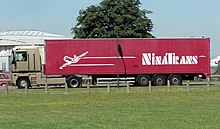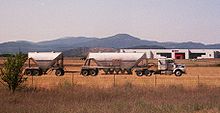A semi-trailer truck is the combination of a tractor unit and one or more semi-trailers to carry freight. It is variously known as a transport (truck) in Canada; semi or single in Australia; semi, tractor-trailer, big rig, or eighteen-wheeler in the United States; and articulated lorry, abbreviated artic, in Britain and Ireland.
A semi-trailer attaches to the tractor with a fifth wheel hitch, with much of its weight borne by the tractor. The result is that both tractor and semi-trailer will have a distinctly different design than a rigid truck and trailer.
In North America, the combination vehicles made up of a powered truck and one or more semitrailers are known as “semis”, “semitrailers”,[1] “tractor-trailers”, “big rigs”, “semi trucks”, “eighteen-wheelers”, or “semi-tractor trailers”.
The tractor unit typically has two or three axles; those built for hauling heavy-duty commercial-construction machinery may have as many as five, some often being lift axles.
The most common tractor-cab layout has a forward engine, one steering axle, and two drive axles. The fifth-wheel trailer coupling on most tractor trucks is movable fore and aft, to allow adjustment in the weight distribution over its rear axle(s).
Ubiquitous in Europe, but less common in North America since the 1990s, is the cabover engine configuration, where the driver sits next to, or over the engine. With changes in the US to the maximum length of the combined vehicle, the cabover was largely phased out of North American over-the-road (long-haul) service by 2007. Cabovers were difficult to service, as the cab could not be lifted on its hinges to a full 90-degree forward tilt, severely limiting access to the front part of the engine.
Trucks average from 4 to 8 miles per US gallon (59 to 29 L/100 km), with fuel economy standards requiring better than 7 miles per US gallon (34 L/100 km) efficiency by 2014.[2]
Rocky Mountain Double

STAA double pup 28.5-foot trailers
The cargo trailer usually has tandem axles at the rear, each of which has dual wheels, or eight tires on the trailer, four per axle. In the US it is common to refer to the number of wheel hubs, rather than the number of tires; an axle can have either single or dual tires with no legal difference.[3][4] The combination of eight tires on the trailer and ten tires on the tractor is what led to the moniker eighteen wheeler, although this term is considered by some truckers to be a misnomer (the term “eighteen-wheeler” is a nickname for a five-axle over-the-road combination). Many trailers are equipped with movable tandem axles to allow adjusting the weight distribution.
To connect the second of a set of doubles to the first trailer, and to support the front half of the second trailer, a converter gear known as a “dolly” is used. This has one or two axles, a fifth-wheel coupling for the rear trailer, and a tongue with a ring-hitch coupling for the forward trailer. Individual states may further allow longer vehicles, known as “longer combination vehicles” (or LCVs), and may allow them to operate on roads other than Interstates.
Long Combination Vehicle types include:
- Doubles (officially “STAA doubles”, known colloquially as “a set of joints”): Two 28.5 ft (8.7 m) trailers.
- Triples: Three 28.5 ft (8.7 m) trailers.
- Turnpike Doubles: Two 48 ft (14.6 m) trailers.
- Rocky Mountain Doubles: One 40 to 53 ft (12.2 to 16.2 m) trailer (though usually no more than 48 ft (14.6 m)) and one 28.5 ft (8.7 m) trailer (known as a “pup”).
- In Canada, a Turnpike Double is two 53 ft (16.2 m) trailers, and a Rocky Mountain Double is a 50 ft (15.2 m) trailer with a 24 ft (7.3 m) “pup”.
Future Long Combination Vehicles under consideration and study for the U.S. MAP-21 transportation bill are container doubles. These combinations are under study for potential recommendation in November 2014:
- 40 ft (12 m) trailer Turnpike Doubles, 148,000 lb (67,000 kg) GVWR
- 40 ft (12 m) and 20 ft (6.1 m) trailer Rocky Mountain Doubles, 134,000 lb (61,000 kg) GVWR
- Double 20 ft (6.1 m) trailers.
The US federal government, which only regulates the Interstate Highway System, does not set maximum length requirements (except on auto and boat transporters), only minimums. Tractors can pull two or three trailers if the combination is legal in that state. Weight maximums are 20,000 lb (9,100 kg) on a single axle, 34,000 lb (15,000 kg) on a tandem, and 80,000 lb (36,000 kg) total for any vehicle or combination. There is a maximum width of 8.5 ft (2.6 m) and no maximum height.[5][6]
Roads other than the Interstates are regulated by the individual states, and laws vary widely. Maximum weight varies between 80,000 lb (36,000 kg) to 171,000 lb (78,000 kg), depending on the combination.[7] Most states restrict operation of larger tandem trailer setups such as triple units, turnpike doubles and Rocky-Mountain doubles. Reasons for limiting the legal trailer configurations include both safety concerns and the impracticality of designing and constructing roads that can accommodate the larger wheelbase of these vehicles and the larger minimum turning radii associated with them. In general, these configurations are restricted to the Interstates. Except for these units, double setups are not restricted to certain roads any more than a single setup. They are also not restricted by weather conditions or “difficulty of operation”. The Canadian province of Ontario, however, does have weather-related operating restrictions for larger tandem trailer setups.[8]
Europe

A semi-trailer truck (Renault Magnum) in London, England
The noticeable difference between tractor units in Europe and North America is that almost all European models are cab over engine, while the majority of North American trucks are “conventional” (called “bonneted” in England). European trucks, whether straight trucks or fully articulated, have a sheer face on the front. This allows shorter trucks with longer trailers (with larger freight capacity) within the legal maximum total length. Furthermore, it offers greater maneuverability and better overall view for the driver. The major disadvantage is that for repairs on COE trucks the entire cab has to hinge forward to allow maintenance access Conversely, “conventional” cab tractors offer the driver a more comfortable driving environment and better protection in a collision.
In Europe usually only the rear tractor axle has twin wheels, while wider single wheels are used for the cargo trailer. The most common combination used in Europe is a semi tractor with two axles and a cargo trailer with three axles, giving five axles and 12 wheels in total. Lesser used (common in Scandinavia) are tractors with three axles, which feature twin wheels either on one or both rear axles. In addition to the most common three axles variant, cargo trailers with only two or only one axle are in use, again usually with larger single wheels.
When using a dolly, which generally has to be equipped with lights and a license plate, rigid trucks can be used to pull semi-trailers. The dolly is equipped with a fifth wheel to which the trailer is coupled. Because the dolly attaches to a pintle hitch on the truck, manoeuvrings a trailer hooked to a dolly is different from maneuvering a fifth wheel trailer. Backing the vehicle requires same technique as backing an ordinary truck/full trailer combination, though the dolly/semi setup is probably longer, thus requiring more space for maneuvering. The tractor/semi-trailer configuration is rarely used on timber trucks, since these will use the two big advantages of having the weight of the load on the drive wheels, and the loader crane used to lift the logs from the ground can be mounted on the rear of the truck behind the load, allowing a short (lightweight) crane to reach both ends of the vehicle without uncoupling. Also construction trucks are more often seen in a rigid + midaxle trailer configuration instead of the tractor/semi-trailer setup.





